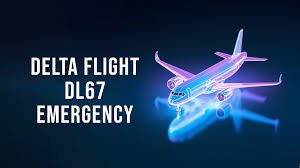Introduction
In the fast-paced world of air travel, safety remains the utmost priority for airlines and passengers alike. However, incidents can occur that challenge this commitment. One such event was the emergency situation involving Delta Flight DL67. This article delves into the details of the incident, exploring its causes, responses, and implications for the airline industry.
Background of Delta Flight DL67
Flight Details
Delta Flight DL67 is a regularly scheduled flight that operates from New York’s John F. Kennedy International Airport (JFK) to Los Angeles International Airport (LAX). The flight is a popular choice for travelers seeking quick cross-country connections.
Aircraft Specifications
The aircraft involved in this incident was a Boeing 767-300ER, a widely used model known for its reliability and efficiency in long-haul flights. Equipped with modern technology and safety features, the 767 is designed to handle various in-flight scenarios.
The Emergency Situation
Timeline of Events
On the day of the incident, Delta Flight DL67 took off from JFK at approximately 6:00 PM local time. Shortly after departure, the crew reported a technical issue that required immediate attention.
- Initial Flight Phase: Within minutes of takeoff, the flight crew noticed unusual readings on the cockpit instruments, indicating a potential malfunction.
- Communication with Air Traffic Control: The captain promptly communicated the situation to air traffic control, requesting permission to return to JFK for an emergency landing.
- Preparation for Landing: The crew initiated emergency protocols, including briefing the passengers and preparing the cabin for landing.
Nature of the Emergency
The technical issue reported by the flight crew involved a malfunction in the aircraft’s hydraulic system, which is crucial for controlling various flight functions, including landing gear deployment and flaps. A failure in this system can compromise the aircraft’s ability to operate safely.
Passenger and Crew Response
In-Cabin Preparations
The cabin crew played a vital role in ensuring passenger safety during the emergency. They followed established protocols, which included:
- Safety Briefing: Informing passengers about the situation and instructing them on emergency procedures.
- Securing the Cabin: Ensuring that all carry-on luggage was stowed, and passengers were seated with seatbelts fastened.
Communication with Passengers
The captain made several announcements during the flight, keeping passengers informed of the situation. Clear communication helped to alleviate anxiety and maintain order in the cabin.
Emergency Landing Procedures
Approach to JFK
As Delta Flight DL67 approached JFK, the flight crew executed emergency landing procedures. They conducted a thorough checklist to ensure that all safety measures were in place.
Successful Landing
The aircraft landed safely back at JFK at approximately 6:45 PM, approximately 45 minutes after takeoff. Emergency services were on standby, ready to assist if necessary.
Post-Landing Protocols
Upon landing, passengers were deplaned via airstairs and taken to the terminal. Delta Airlines provided support, including counseling services and arrangements for passengers to rebook their travel plans.
Investigation of the Incident
Initial Investigation
Following the incident, the Federal Aviation Administration (FAA) launched an investigation to determine the cause of the hydraulic system failure. The National Transportation Safety Board (NTSB) also conducted a separate investigation to assess the overall safety protocols followed by the airline.
Technical Analysis
The investigation revealed that a combination of factors contributed to the hydraulic system failure, including:
- Wear and Tear: The aircraft had experienced normal wear and tear, which affected the hydraulic components.
- Maintenance Records: A review of maintenance records indicated that while routine checks had been conducted, a deeper inspection may have been necessary.
Implications for Delta Airlines
Safety Protocols Review
In response to the incident, Delta Airlines conducted a thorough review of its safety protocols and maintenance procedures. The airline emphasized the importance of proactive maintenance and the need for regular training for flight crews in handling emergencies.
Passenger Trust and Reputation
Incidents like the Delta Flight DL67 emergency can impact passenger trust. Delta Airlines took steps to reassure customers, including:
- Transparency: Keeping the public informed about the incident and the steps taken in response.
- Customer Support: Offering compensation and support to affected passengers to maintain goodwill.
Industry-Wide Repercussions
Regulatory Changes
The incident prompted discussions within the aviation industry regarding regulatory changes related to aircraft maintenance and safety standards. Regulatory bodies began to consider implementing stricter guidelines to prevent similar occurrences in the future.
Best Practices for Airlines
Airlines worldwide are continuously refining their safety protocols based on lessons learned from incidents like Delta Flight DL67. Best practices include:
- Enhanced Maintenance Procedures: Implementing more rigorous inspection and maintenance schedules.
- Crew Training: Providing ongoing training for flight crews in emergency response and communication.
FAQ’s
1. What caused the delta flight dl67 emergency?
The emergency was caused by a malfunction in the aircraft’s hydraulic system. The hydraulic system is crucial for controlling various flight functions, including landing gear and flaps. The malfunction prompted the crew to return to the departure airport for an emergency landing.
2. How did Delta Airlines respond to the emergency?
Delta Airlines responded promptly by following emergency protocols. The flight crew communicated with air traffic control and prepared the cabin and passengers for an emergency landing. After landing safely, Delta provided support to passengers, including rebooking their flights and offering counseling services.
3. Were there any injuries reported as a result of the incident?
Fortunately, there were no injuries reported. The emergency landing was conducted safely, and the aircraft landed without incident. Passengers and crew disembarked without harm, and emergency services on standby were not needed.
4. What actions were taken to investigate the incident?
The Federal Aviation Administration (FAA) and the National Transportation Safety Board (NTSB) conducted investigations to determine the cause of the hydraulic system failure and assess the airline’s safety protocols. The investigations revealed that normal wear and tear, along with maintenance factors, contributed to the malfunction.
5. How has Delta Airlines addressed the issue following the incident?
Delta Airlines conducted a comprehensive review of its safety protocols and maintenance procedures in response to the incident. The airline emphasized enhanced maintenance checks, regular training for flight crews, and improved communication with passengers to ensure similar issues are effectively managed in the future.
Conclusion
The emergency situation involving Delta Flight DL67 serves as a reminder of the complexities and challenges faced by the aviation industry. While the incident was resolved without serious consequences, it highlights the importance of safety protocols, effective communication, and the need for continuous improvement in airline operations. As the industry evolves, lessons learned from such events will contribute to safer air travel for all.







